Physical Address
304 North Cardinal St.
Dorchester Center, MA 02124
With thanks to the authors of the sixth edition, Pasquale Giordano, David J. Humes and John H. Scholefield.
Anal cancer is predominantly (90%) squamous cell in origin, and 90% of anal squamous cell carcinoma (ASCC) is caused by the human papillomavirus (HPV).
This chapter will outline what the surgeon needs to know about HPV infection, anal low- and high-grade intra-epithelial lesions (LSIL and HSIL) – otherwise known as anal intra-epithelial neoplasia (AIN) – as well as ASCC. Non-HPV origin and non-squamous rare anal cancers will be covered in a section towards the end of the chapter.
The distal anal canal is lined by stratified squamous epithelium, the natural host tissue for HPVs. Stratified squamous epithelium is hair-bearing and keratinising in the perianus, becomes non-hair–bearing at the anoderm of the anal verge, and is non-hair–bearing and non-keratinising in the lower anal canal. The dentate line is the macroscopic marker of the junction of the embryological ectoderm and the embryonic hindgut at about one third along the length of the anal canal. However, the squamous epithelium of the lower anal canal forms a squamocolumnar junction (SCJ) with the upper anal canal more cranially than the dentate line. This zone of transition between two epithelial types is particularly susceptible to HPV-related disease in the anus, as it is in the cervix.
The perianus is defined as 5 cm from the anal verge or margin (the edge of the anal opening visible with the buttocks gently parted) and, since 2018, the 8 th edition of the American Joint Committee on Cancer (AJCC) has defined perianal cancers as anal as opposed to skin cancers. Most ASCC arise from the squamous epithelium of the anal margin or anal canal, although a few arise from anal glands or ducts and the extremely rare rectal SCC is thought to arise from squamous metaplasia in the rectum.
The upper anal canal above the SCJ is lined with columnar epithelium, identical to rectal mucosa. The majority of cancers of the upper anal canal are therefore adenomatous in origin and are treated as extensions of low rectal cancer, although a rare anal-origin adenomatous cancer does occur.
Papillomaviruses are a group of ubiquitous non-enveloped double stranded deoxyribonucleic acid (DNA) viruses of which a subset of around 150 are pathogenic to humans. Those of interest here are mainly in the α-papillomavirus group with a predilection for the anogenital skin and mucosa. As well as causing benign hyperproliferative lesions and flat pre-malignant change, HPVs are implicated in around 25% of oropharyngeal cancers, cause the majority of penile, vaginal and vulval cancers and cause 90% of cervical and anal invasive squamous cell carcinomas.
HPV of the lower anogenital tract is sexually transmitted. This fact can lead to much distress among patients and needs to be managed carefully by the colorectal surgeon. Eighty-five to 91% of adults have met the HPV virus, unless they were vaccinated against it prior to sexual debut and overall prevalence in US adults is 42%. HPV is passed on orally, by genital touching, by finger or toys as well as penetrative sex; condom use reduces but does not eliminate the risk. The prevalence of anal HPV is highest in men who have sex with men (MSM) living with human immunodeficiency virus (HIV) (90%) and HIV negative (60%), however, anal HPV can also be found in men who have sex with women (MSW) (12%). In women, anal HPV carriage is more common (42%) than cervical (27%) and HPV prevalence in the anus is higher if the woman is living with HIV (68–87%).
Multiple partners, smoking and anoreceptive intercourse all increase the likelihood of anal HPV carriage , but are not necessary for it. In women, anal HPV is most often caused by self-inoculation (wiping after opening bowels) with a sixfold higher anal HPV carriage after front-to-back compared to back-to-front wiping.
Anal pre-cancerous and malignant disease is higher in women with a previous history of genital HPV-related disease, particularly the vulva ( Fig. 8.1 ). Women with disease at multiple anogenital zones are termed to have multizonal intra-epithelial neoplasia, which poses a substantial risk of lower anogenital tract HPV-related SCC.
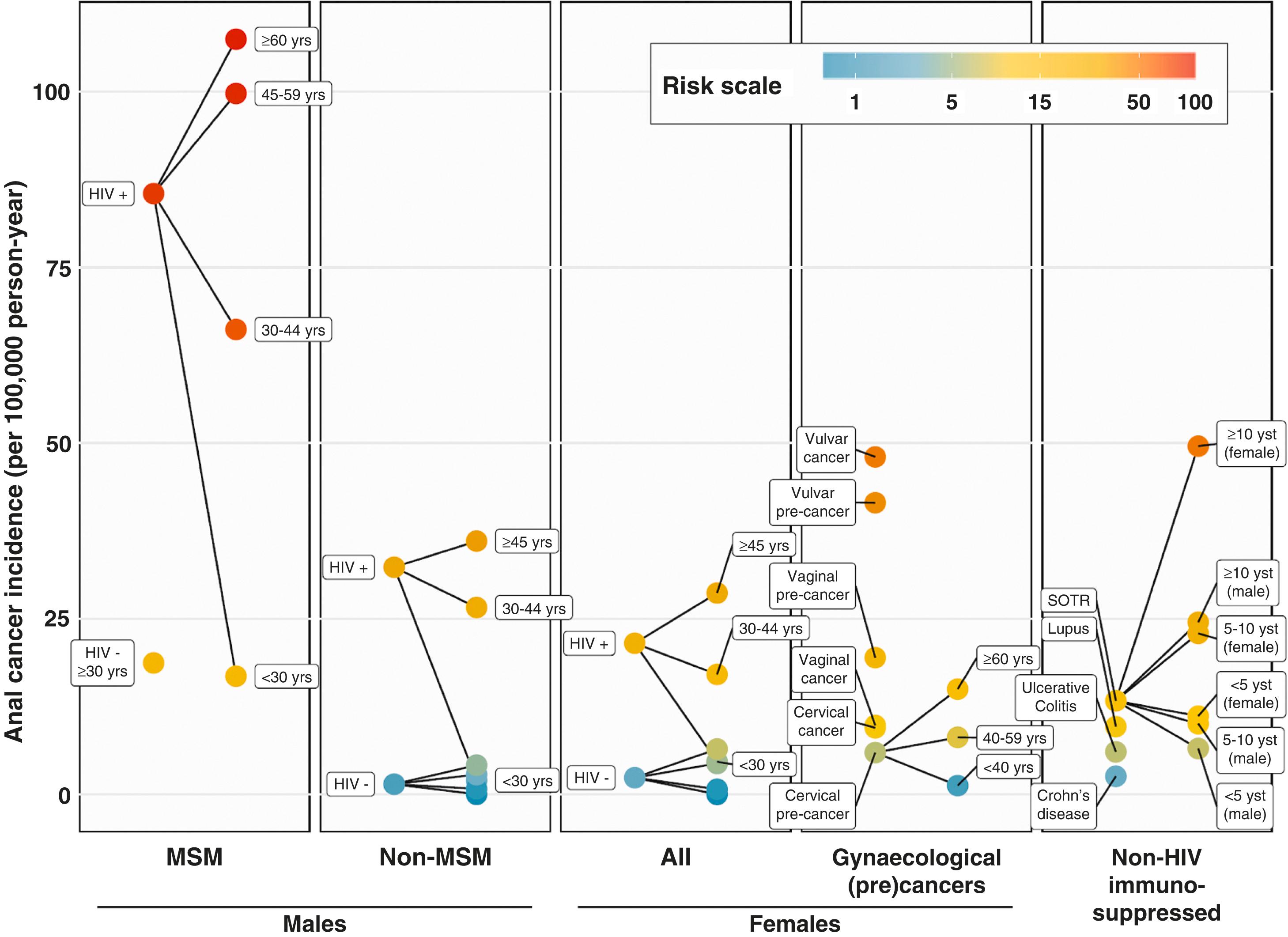
Given that HPV causes the vast majority of anogenital warts, pre-cancer and squamous cell cancer, it stands to reason that patients susceptible to infection are at greater risk in particular those with innate and acquired immune defects. For persons living with HIV (PLWH), years living with undetectable viral load (VL) versus detectable VL reduces the risk of ASCC by 44% and for every rise of 100 cells/μL CD4 nadir, the anal cancer risk drops by 40%. ,
Other at-risk groups include solid organ transplant recipients especially more than 10 years after transplant, and patients on long-term pharmacological immune suppression for systemic lupus erythematosus, rheumatoid arthritis, Crohn’s and ulcerative colitis. Immune suppression seems to bring the disease forward with an accelerated path to SCC in patients’ 40s and 50s. Nonetheless, age in the absence of immune suppression is a sufficient risk factor: the incidence of anal SCC is higher in women than men in the general population with a median age of over 80 years ( Fig. 8.2 ).
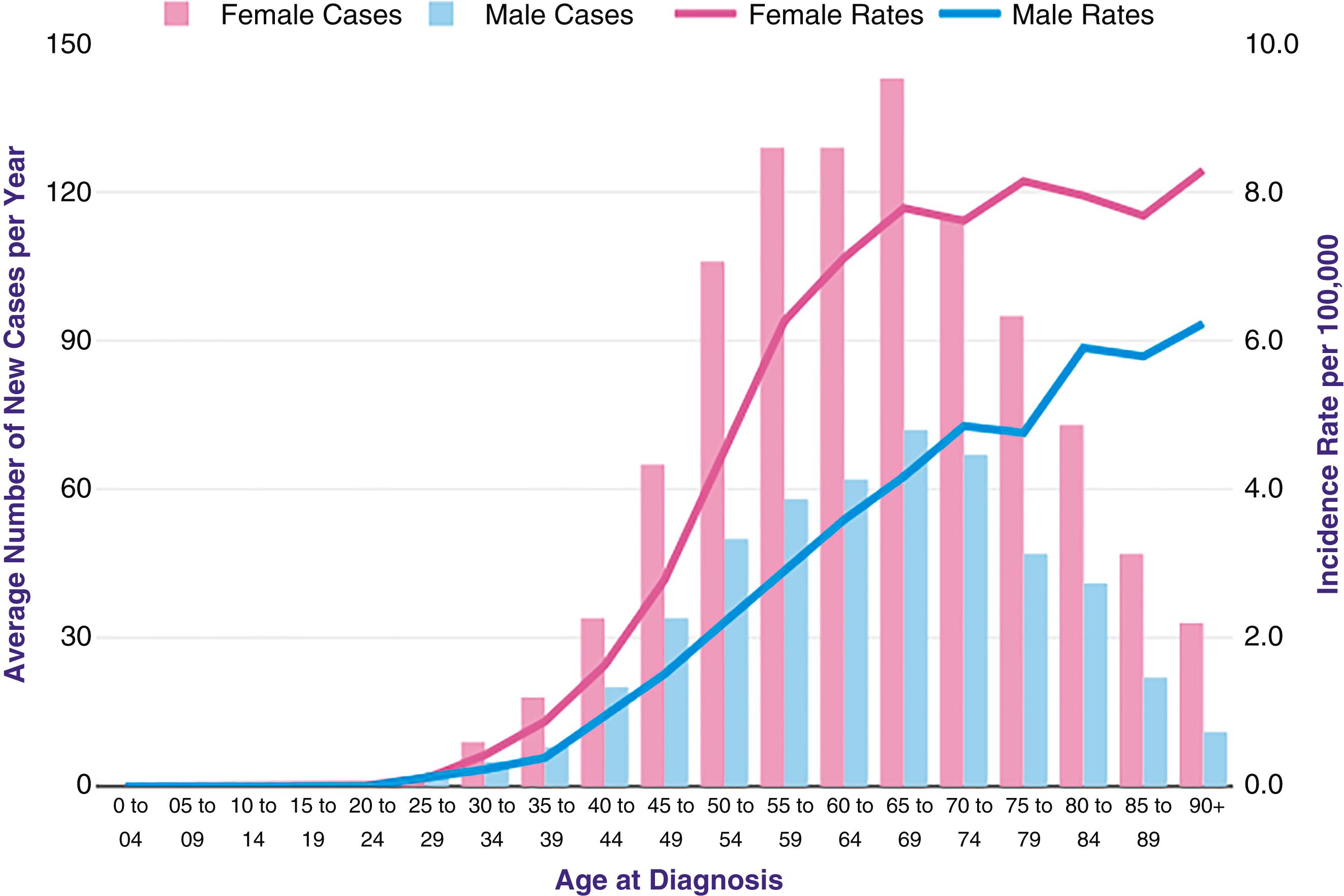
There are increasing numbers vaccinated against HPV with substantial worldwide impact. The UK and other high-income countries began vaccinating girls against the oncogenic HPV types, 16 and 18, in 2008. Additional protection against genital warts, HPV 6, 11, followed with the quadrivalent vaccine. Protection is almost 100% against vaccine types in the HPV-naïve. Already this has led to a reduction in cervical disease and anogenital warts in not only women, but also men. Boys have been vaccinated since 2019 in the UK and 2011 in the United States, and a nonavalent vaccine is available covering types 6, 11, 16, 18, 31, 33, 45, 52, 58.
Vaccine-related reduction in ASCC will happen later than cervical cancer because of the lengthy lead time from infection to disease in the anus (20–40 years). HPV vaccination of the already-exposed person has been trialled in HIV negative MSM aged between 18 and 26 years in a placebo-controlled randomised controlled trial (RCT). Reduction of AIN by vaccine in the intention-to-treat arm was 50% and 77% in the per-protocol treatment group. However, no impact was seen when repeated in older MSM. A modest impact of the vaccine in HPV-DNA negative women up to the age of 45 years has been found. In the UK, HPV vaccination is available on the National Health Service for MSM up to the age of 45 years as this group has no herd protection from the vaccination of girls.
![]() HPV vaccination against high-risk types 16 and 18 is reducing anogenital wart and cervical pre-cancer and cancer incidence. ,
HPV vaccination against high-risk types 16 and 18 is reducing anogenital wart and cervical pre-cancer and cancer incidence. ,
![]() HPV vaccination of HIV negative 18–26-year-old gay men results in at least a 50% reduction in anal HSIL.
HPV vaccination of HIV negative 18–26-year-old gay men results in at least a 50% reduction in anal HSIL.
HPV types 6 and 11 are the main cause of anogenital warts, the vast majority of which have no malignant potential. Given the prevalence of anal HPV in unvaccinated adults, the majority must not form warts on first contact with HPV. Nonetheless, anogenital warts are common, with an incidence of 160–289/100 000 person years. They tend to occur in the young and usually present to sexual health departments in the UK.
Immune clearance of HPV after infection can be incomplete, with integration of the viral genome into basal cells, which, given no viral reproduction and immune evasion, allows persistent virus to be present for many years, only to display pathological effects later in life. Lesions can also develop soon after infection, producing small, often multiple, discrete outcrops of raised circular lesions, brown or skin colour with a corrugated surface, recognisable as warts, or condyloma acuminata ( Fig. 8.3 ). Initially soft or nodular, both perianal and anal canal warts can grow large and confluent leading to irritation, bleeding and mucus production.
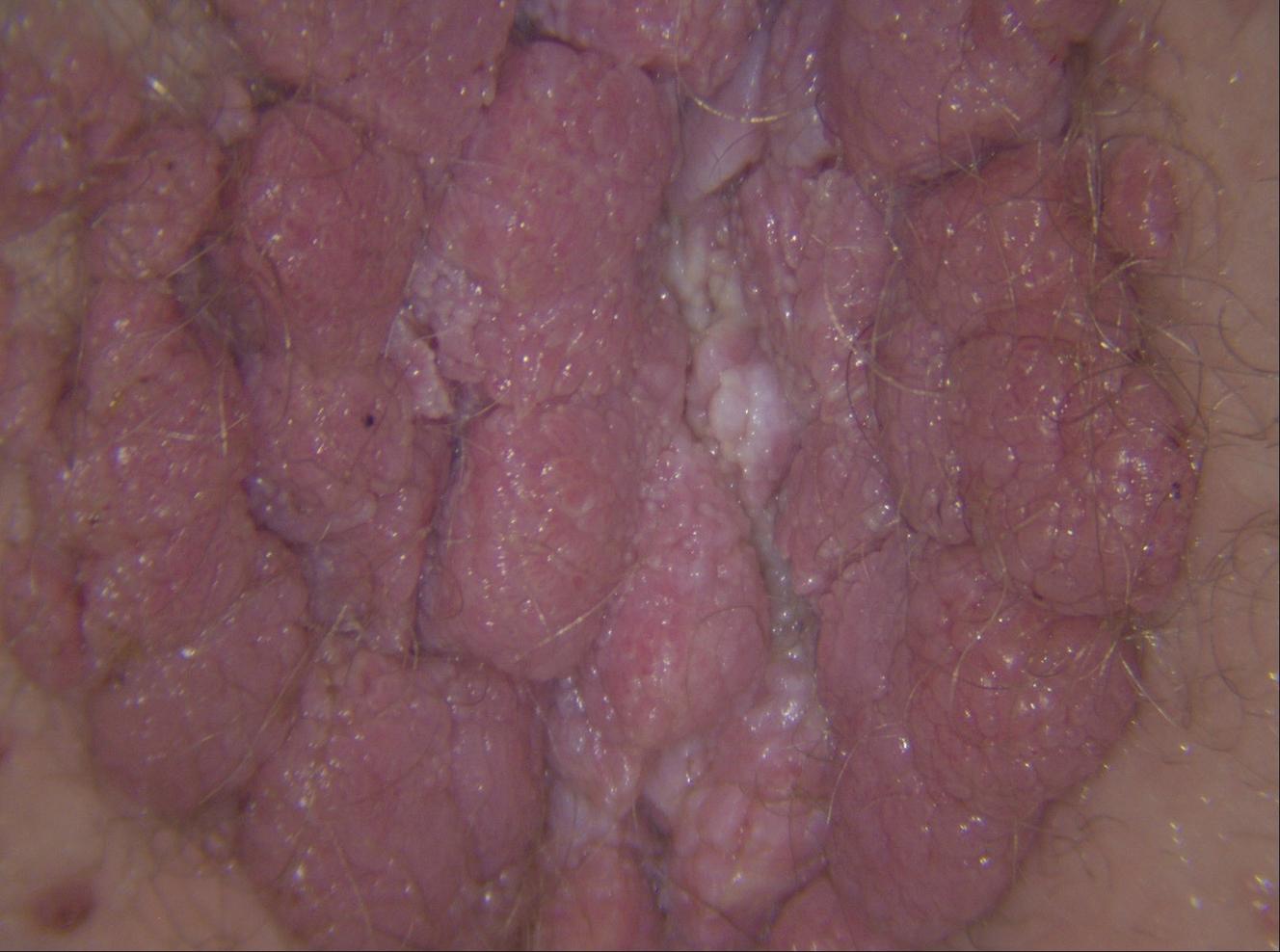
Warts are low risk and benign, although high-risk oncogenic HPV types can be involved in the immunocompromised. The evidence for wart management is lower quality in PLWH but the same range of treatments can be used as in the HIV negative. Warts in themselves are considered a risk factor for anal cancer in PLWH.
Diagnosis is by physical examination, with histological confirmation not necessary unless there is concern of a risk of cancer caused by age, risk factors or unusually intense symptoms. Pain is unusual, although very dense warts can fissure between them, and clinical examination should not discover deep attachment to the submucosa/subcutaneous layers. Simple unenhanced proctoscopy is recommended, particularly for MSM, for anal canal warts ( Fig. 8.4 ). Vulvovaginal or penile examination may be indicated, and women should be sent for a cervical smear if not in the cervical screening programme.
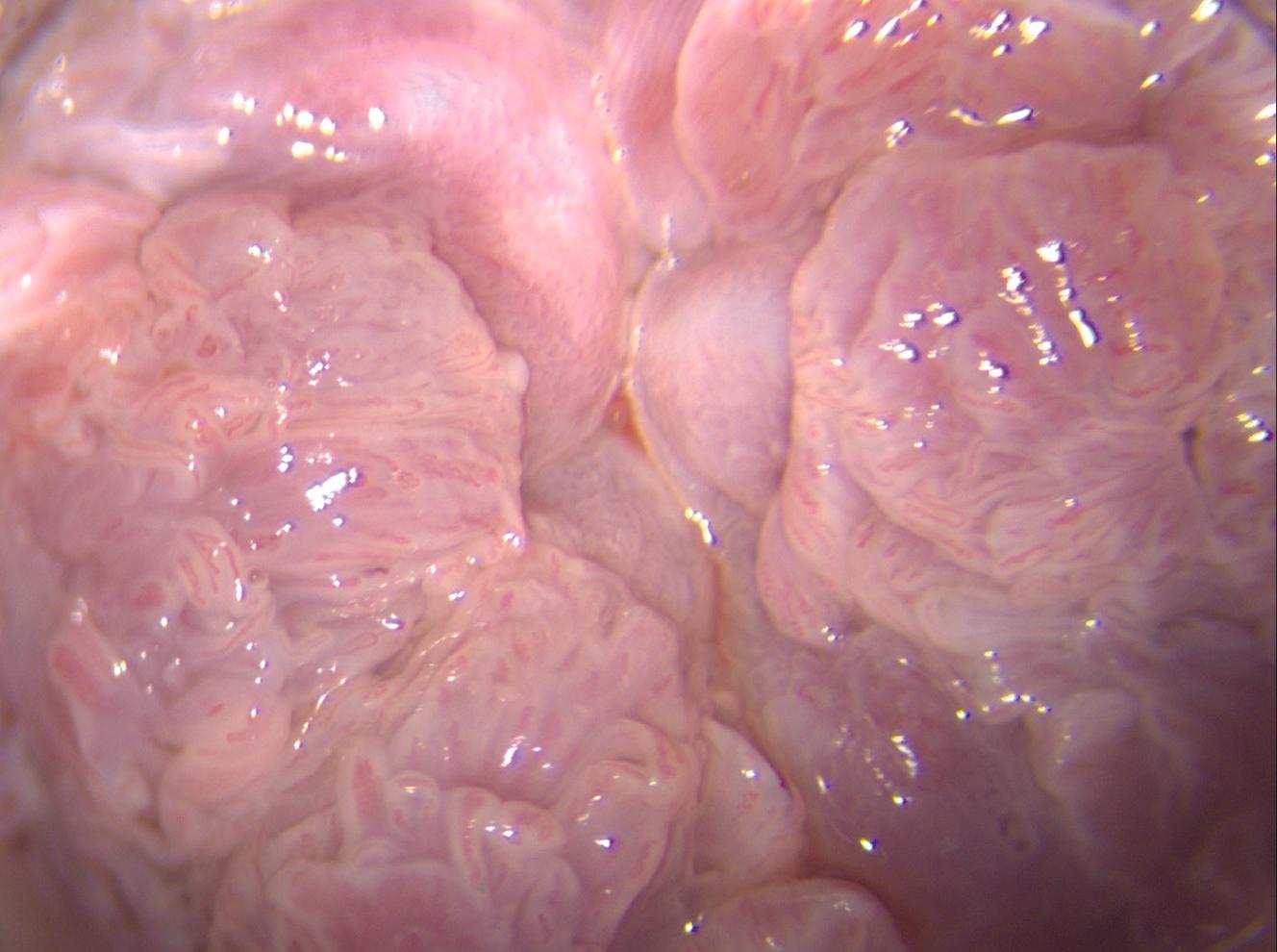
A sexual health screen for other sexually transmitted infections (STIs) and counselling are suggested, with topical therapy and cryotherapy first-line treatments. For warts of the perianus, patient-applied creams are approved for external use and require 3–4 months of application: 5% imiquimod, a topical immune stimulant (toll-like receptor 7) is 35–75% effective, , and sinecatechins (green tea-derived immunomodulators, multiple pathways) have been shown to be 50–60% effective, albeit PLWH were excluded from trials. Provider-administrated therapy includes cryotherapy (success 44–87%), and topical ablation with trichloroacetic acid, success 60–90%. Recurrence rates are substantial for all treatments (25–60% at a year) and most cause local irritation and burning.
Low-volume anal canal warts do not necessarily require treatment, albeit the patient will be more infectious with active lesions. Options include the aforementioned non-surgical therapies used for the perianus, however, these are not licensed for intra-anal use and are less successful in the anal canal. Cryotherapy is not used inside the anal canal.
Surgeons tend to be referred cases of warts that are recalcitrant to treatment. Surgical excision, electrocautery/hyfrecation and laser have a success rate of 95–100% with recurrence rate of 20%. , This can be achieved under local anaesthetic (1% or 2% lidocaine with adrenaline, or a posterior pudendal nerve block with 40 mL of 0.25% levobupivacaine), although a general anaesthetic will be required for large volume disease. Electrocautery and laser are less likely to penetrate the deep dermis and cause scarring. FFP3 masks should be used due to the risk of aerosolised particles with laser and electrocautery. Site of excised lesions should be documented, and specimens sent for histology in the immune suppressed or patients over 40 years as warts can contain focal areas of high grade.
Surgical excision should be considered carefully: do not leave any less of the mucosa than you would at a haemorrhoidectomy as life-changing anal stenosis can result, particularly if the patient is also defunctioned. If the multiple lesions have a narrow base, then the base or pedicle can be transected, leaving normal skin/mucosa between wounds, allowing full excision. If the lesions are confluent, there is no harm in staging the procedure over two, three or even four visits to minimise the risk of stenosis.
![]() First-line treatment of perianal warts is topical treatments of imiquimod or sinecatechins. ,
First-line treatment of perianal warts is topical treatments of imiquimod or sinecatechins. ,
![]() Surgical excision or ablation is successful but beware stenosis and stage large procedures.
Surgical excision or ablation is successful but beware stenosis and stage large procedures.
Buschke and Lowenstein described giant condyloma acuminata (GCA) in 1925. It is a highly recurrent locally invasive tumour of low malignant potential associated with low-risk HPV types 6 and 11. GCA is large in diameter (6–12 cm) and also in depth (up to 4 cm), appearing as densely packed firm warts, broad-based with a finely irregular surface ( Fig. 8.5 ). Patients are predominantly male, often smokers. There is some overlap with verrucous SCC. Magnetic resonance imaging (MRI) shows the tumour superficially infiltrating usually with no invasion of underlying muscle and T2 hyperintensitivity.
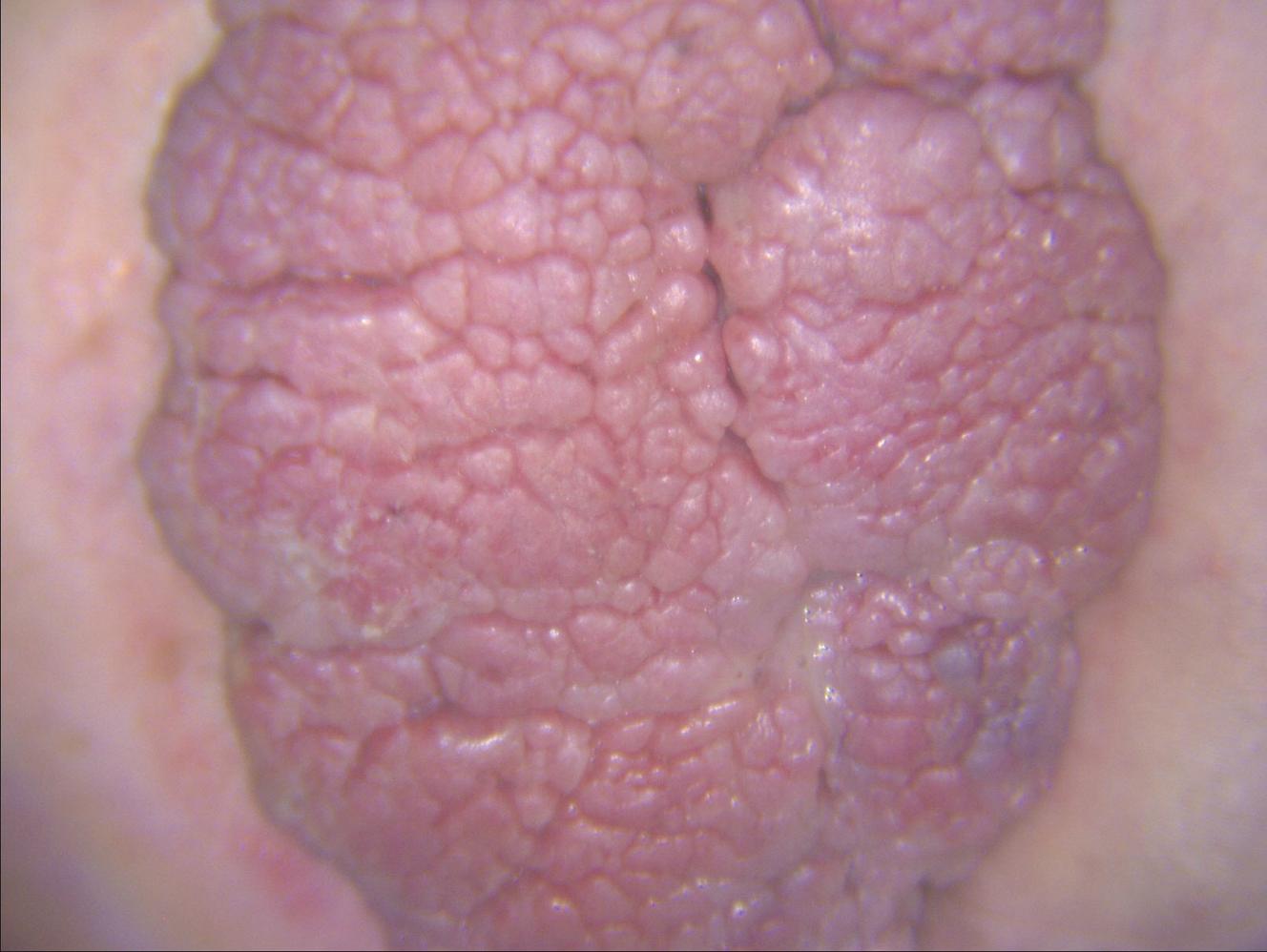
There is no good evidence for treatment, but 5% imiquimod, photodynamic therapy, acitretin, cidofovir, chemotherapy combined with surgical excision, and chemoradiation (CRT) have all been tried. Patients often fail local ablation or excision, undergo skin grafts and end up with a defunctioning stoma, stenosis and eventual abdominoperineal excision.
AIN is an HPV-related, usually flat, dysplastic change in the squamous mucosa and skin of the anal canal and perianus. The Lower Anogenital tract Squamous Terminology consensus statement in 2012 unified the terminology for HPV-related pre-cancerous dysplasia of the lower anogenital tract, reflecting the biological distinction between LSIL, the result of proliferative infection with HPV and not considered pre-cancerous, and HSIL, from oncological transformation of the cell, characterised by the expression of HPV genes E6 and E7.
So, AIN is anal LSIL or HSIL; -IN1 is the histological grade for dysplasia in the lower third of the epithelium. Histology, particularly -IN2 (dysplasia of the lower 2/3) is known to have low Cohen’s Kappa values for histopathologists, indicating significant diagnostic variation. The introduction of biomarker p16 with immunohistochemistry has enabled the distinction between LSIL, which is -IN1 and cases of -IN2 where p16 staining is negative, and HSIL, which is -IN2 with block positive p16 staining plus -IN3, full thickness epithelial dysplasia, confidently diagnosed without p16 staining and previously termed carcinoma-in-situ .
p16 is a tumour suppressor protein, which facilitates the binding of transcription factor E2F to the retinoblastoma protein (pRB) leading to cell cycle arrest. The E7 protein of an oncogenic HPV binds preferentially to pRB, while the HPV E6 protein deactivates p53 preventing apoptosis. The cell, taken over by oncogenic HPV, is now driven by uninhibited E2F and goes into deregulated proliferation with p16 over-expression.
Anal squamous intra-epithelial lesions (SIL) are usually asymptomatic while anal SCC is usually symptomatic. There are cases where extensive anal/perianal HSIL causes itching, soreness and pain, however, these should be carefully assessed and biopsied particularly at spots of ulceration or where the patient has pain to exclude focal SCC ( Fig. 8.6 ). Macroscopically, anal SIL can appear as warts, or flat pink or red lesions, or grey or darker pigmentation in brown or black skin. The pigmented areas tend to be irregular in outline. Closer inspection shows dots visible (abnormal vasculature) and some more advanced lesions are thickened. Vascular patterns of SIL are similar to those seen in the cervix at colposcopy. Some are impossible to detect with the naked eye.

For both perianal and anal canal SIL, the technique of high-resolution anoscopy (HRA) is considered the gold standard worldwide to visualise the SCJ and identify SIL for targeted biopsies. In a technique analogous to colposcopy, 5% aqueous acetic acid is used through an ordinary proctoscope with high-resolution real-time high-quality magnification by colposcope up to 30 times. Regions of active HPV mucosal infection turn cloudy white (acetowhite), and SILs are visible with abnormal vessel patterns showing as irregular lines (mosaic change), straight lines (striations) and dots (punctation) ( Fig. 8.7 ). Standards have been set for carrying out the procedure. Anal cytology can be carried out for detection of dysplasia from the anal canal before HRA (Floq swab in liquid-based cytology medium) as can swabs for high-risk HPV, but neither test yet has the sensitivity required for a screening programme for high-risk groups.
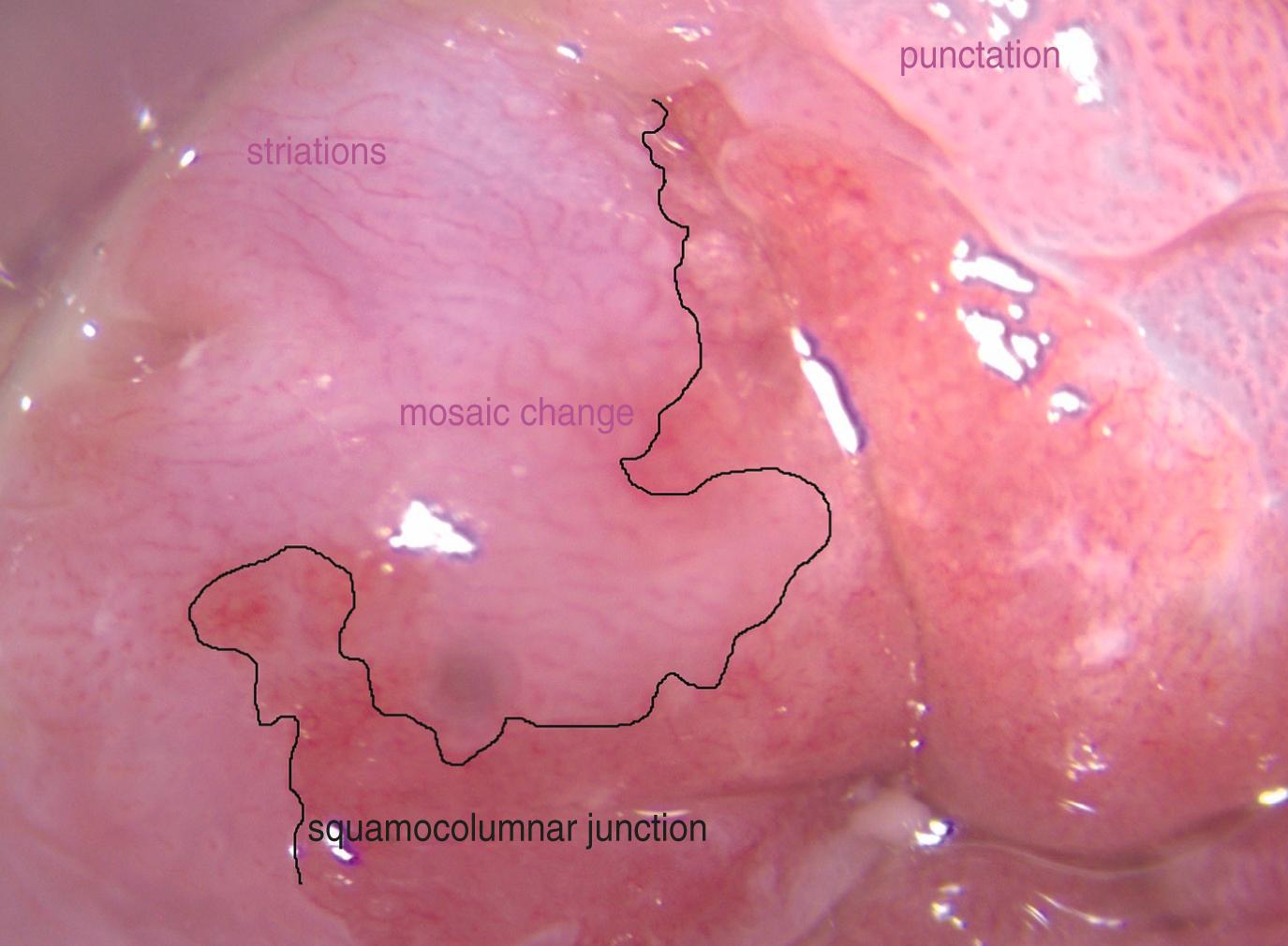
Anal canal SIL can be detected and biopsied at endoscopy with a retroflexed view and relaxation of the anorectal junction plus narrow band imaging, with the diagnosis a surprise to most endoscopists.
Anal HSIL is highly prevalent in high-risk groups. PLWH, especially MSM, have been the most studied with a prevalence of anal HSIL of 29–33%; , in women living with HIV prevalence is 27%, and 17% in those with no history of anal intercourse. The odds ratio for renal transplant recipients having anal HSIL, controlled for factors of age, lifetime sexual partners, anal intercourse and smoking was 11.2 for men and 8.3 for women, with an overall prevalence of 27/247 (11%). Of note, 4% of the female and 0.8% of the male non-transplanted controls had anal HSIL with no known risk factors.
Progression of anal HSIL to anal cancer is not inevitable and the diagnosis has to be put in context for patients. The risk of SCC varies from 1 in 456 per year for MSM living with HIV and 1:4000 per year for those without HIV to 9.5% at 5 years. There is also regression of anal HSIL, approximately 25% at 6 months. A study from the specialist unit in San Francisco demonstrates photo documentation of anal HSIL lesions left untreated, returning as invasive lesions at the same location in 27 patients.
DNA methylation of host and HPV genes in the anus – as for the cervix – seems to predict the progression of HSIL to cancer, and may enable the identification of at-risk lesions for treatment in the future, strengthening the case both for treatment and for screening. , In HIV-positive MSM, progression from LSIL or no SIL to HSIL was 55/1199 patients over 1–5 years. At present, the evidence is that AIN3 is more likely to progress than AIN2 p16+ve and less likely to regress and the relative risk of cancer for HSIL treated with ablation versus no treatment has been shown to be 0.3.
Become a Clinical Tree membership for Full access and enjoy Unlimited articles
If you are a member. Log in here